Old Stagecoach Trail Property
Chatsworth Park South – map
Declared: 1/5/72
Not a great post, sort of half-assed. But I will say this: I sweat more getting these shots than for nearly all the other monuments combined (not including Plaza Park back on that sweltering Labor Day, of course).
I trekked out to Chatsworth Park South and the Santa Monica Mountains a few weeks ago to look for the plaque put up by the Native Daughters of the Golden West in 1939. It was placed to commemorate the 19th-century stagecoach trail that led from the San Fernando Valley, over the Santa Susana Pass, into Simi Valley, and beyond. I veered in the wrong direction, though, and couldn’t find squat.
So I re-trekked it back on the first Sunday of the month to get some assistance from the folks at the Chatsworth Historical Society, headquartered in the park. Helen, Betty, and Jim were a big help. Thanks. The first thing they did was point out the location of the sign, way up on the mountainside, to which I dutifully hoofed it.
Once an Indian trail, the pass was given a few names during the Spanish Colonial era, and all incorporated the name of the 3rd-century martyr St Susana. In the early 1800s, it was suggested the Santa Susana Pass might be a shorter/better route between the San Buenaventura and San Fernando Missions as opposed to the El Camino Real, the road whose raison d’être was to connect the missions.
The pass continued to be used more and more as control went from Spain to Mexico to the United States, like for agricultural goods, cattle, sheep, and eventually mail.
In 1859, the state put up $15,000 to fix up the Santa Susana Pass Wagon Road, under the supervision of James P. Thompson. Thompson was also the man awarded the contract to use the pass for carrying mail. The first overland stagecoach to use the pass made its run between San Francisco and Los Angeles on April 6, 1861. The trip took 72 hours.
That's the trail, right there.
Another thing the Historical Society crew tipped me off about was the Devil’s Slide, the portion of the trail where the grade was so steep that extra precautions were needed to prevent accidents involving runaway coaches. These precautions included tricks such as tying wheels together, using a windlass, blindfolding easily spooked horses, and cutting step grades into the stone paths.
The Santa Susana Pass became the main transportation link between L.A and San Francisco during the Civil War and remained so for about a dozen years. However, a group of new owners abandoned the stage line in 1875, although local ranchers and farmers continued to use the pass. The Chatsworth Grade Road (pretty much the 118 today), built in 1895, rendered the old Santa Susana Pass obsolete.
The Topanga Parlor of the Native Daughters of the Golden West placed the commemorative tiled plaque by Devil’s Slide on St Patrick’s Day in 1939. Yeah, the plaque’s misspelled. One of the participants in the dedication was John Steven McGroarty.
So while I did find the sign after it was pointed out, I was clueless when it came to spotting old pick and ax marks and retaining walls and such. I was also disappointed when I couldn’t discover some old cisterns used to water the horses. But, most disappointing of all, I couldn’t find the remains of the De la Osa swing station where extra horses would be hitched to stagecoaches to help with making the arduous trip up the side of the hill (or unhitched after the way down). All this stuff is still to be found, along with remnants of the quarry days from a hundred years ago.
Now, are these stagecoach ruts in the two pictures below?
After telling the Historical Society gang how I came up fairly empty on my search for stagecoach trail remains, I was encouraged to get in touch with the Santa Susana Mountain Park Association (SSMPA), a non-profit group founded in 1970. The group gives guided hikes of the trail and Santa Susana State Park on the third Sunday of each month. Will do.
One thing that is hard to miss, even for me, is the structure at the entrance to Chatsworth Park South. During the area’s mining days, this little building was a dynamite shack (coincidentally the name of my funk band in the 70s).
If you want to know all there is to know about Santa Susana State Park and its history, read Alexander D. Bevil’s comprehensive historic overview from this spring and 2005’s archaeological overview by Marla Mealey and Natalie Brodie. Both publications are from California State Parks, and they’re where I got much of this post’s information.
Up next: Pepper Trees

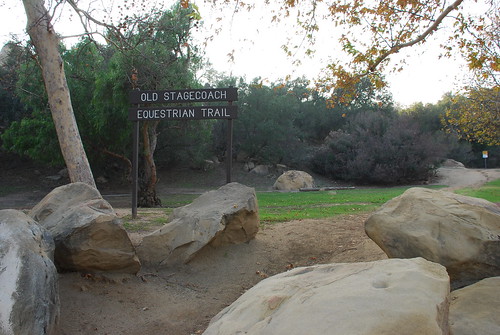

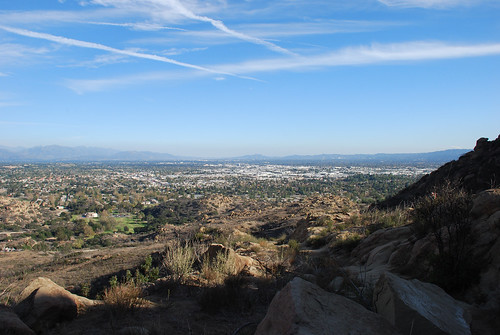
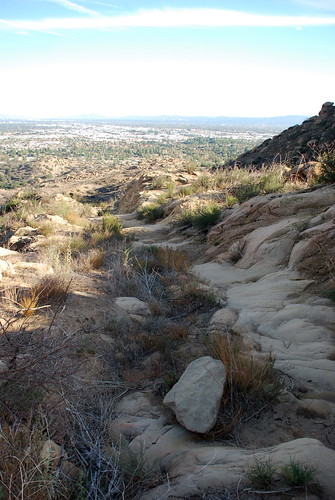

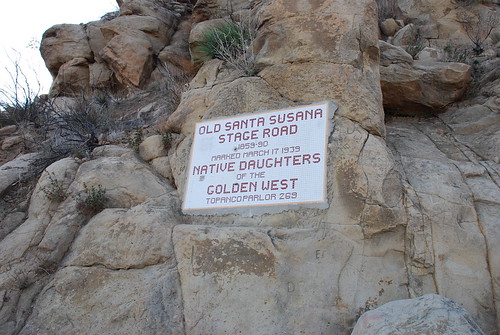
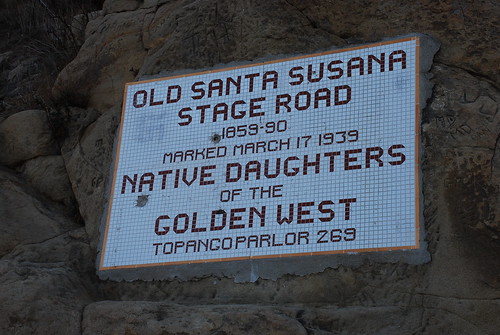

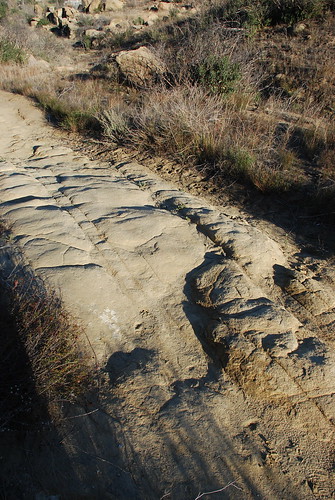
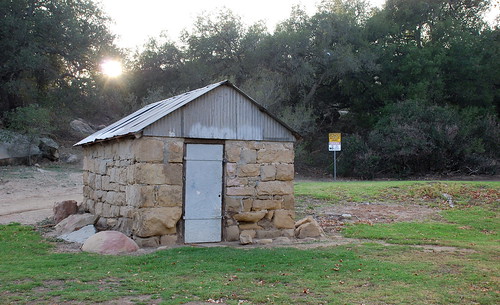

8 comments:
Never been to that part of the 'world' ... looks to be a pretty large area. I see a trek in my future.
Your blog is addictive. Links to old post cards, to history and sharing your enlarged photos. You are the most generous of bloggers.
I've been here too! that last stretch over the wagon wheel tracks was a challenge. I continued past this point. Eventually I came across a street. Somewhere near was a continuation of the trail overlooking the Semi Valley. (I think). I've always wanted to go back.
Thanks, Palm Axis. I actually met some hikers who had come from the Simi side while I was there. The area is loaded with trails, isn't it? I need to get back before the blazing summer to search for other old remnants.
My Grandfather used this trail in the 1910's and early 20's when he took his family (my grandmother and anuts and uncles) by wagon from Oxnard to San Fernando every season for work in the fields. They used to live in tent shacks with many other Mexican families near Sylmar on Celis Street near Wolfskill. Thanks for the info, I plan to go see the road that was used by my family so many years ago!
Michael Ontiveros
Hi, Michael. I had no idea the trail was being used that far into the 20th century. Before you head out, check with L.A.'s Parks Department - Chatsworth Park South has been closed since February as the soil gets tested for lead.
I was very interested in the photos of Catsworth businesses district-1949. The Market was McElveyn,s where as a little boy I spent a lot of time (in the summer) sitting on the dock of the Ice House drinking sodas with my buddys. My Brother-In-Law to be worked as a fry cook at the Town and Country Cafe next door. It was owned by the Jotton family. Across Topanga Blvd. from there was Holt's Drug Store with a great fountain where after school the kids would go for Cherry or Lemon Phosphates. Next to that was a 5 & 10 Cent store and then Morrow's Shoe Repair.I attended Chatsworth Park Elementary School across Devonshire St. from afore mentioned cafe from grade 3 through 6. The principle was Laverne A. Lee. Some of my teachers were Mr. Ablared, Miss Bates, Mrs. Gerard, and most fondly remebered my 6th grade teacher Mrs Glenn. We lived at 22061 Devonshire from 1948 until about 1954.----I could go on and on about the people and businesses there at that time. ---Mike W.
Thanks, Mike. I've felt Chatsworth retains a lot more of a mid-century feel than most of L.A., but just by you mentioning phosphates and 5 and 10 stores, I guess it's changed a lot, too. It's great you have those memories.
I was just there last Sunday after wanting to see the place, Devils slide and all, for myself. I am a university trained archealogist and I wanted to see if there is any stagecoach station remants left. I could NOT find any. My metal detector is non-functioning, but would love to hit this area with it another time. That whole area with stagecoach rodes must be full of lost artifacts. I know the area was later Roy Rodgers gun club and private home in the late '30's. It just cowboy era stuff everywhere. Great fun for a SFV native boy.
Post a Comment